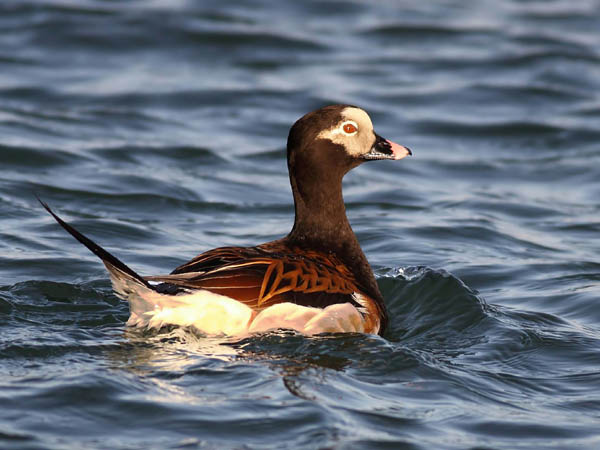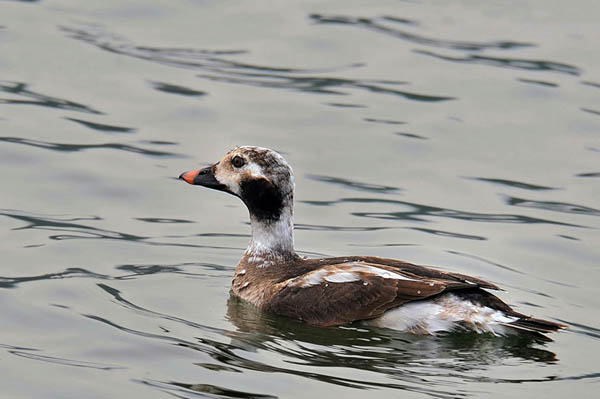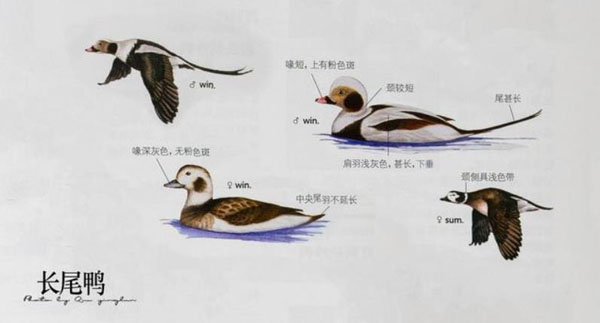Clangula hyemalis
IUCN
LCBasic Information
Scientific classification
- name:Clangula hyemalis
- Scientific Name:Sharp-tailed duck, long-tailed duck, long-tailed duck, gun-towed duck, Chinese duck,Clangula hyemalis,American Wigeon
- Outline:Waterfowl
- Family:Anseriformes Anatidae L.Duck
Vital signs
- length:534-580mm
- Weight:520--1000g
- lifetime:6-8years
Feature
A medium-sized grey, black and white duck with long central tail feathers. It is a very rare winter migrant.
Distribution and Habitat
In China, it is found in the Bohai Sea, the Yellow Sea and the East China Sea in winter, and there are also records of wintering in the middle and lower reaches of the Yangtze River, as well as in Sichuan and Xinjiang. Abroad, it is distributed in the waters of the Holarctic circumpolar region and winters in the coastal waters of the Holarctic region.
Like many waterfowl, the long-tailed duck has two different habitats. In summer, it appears in grasslands and dwarf birch forests, including tundra vegetation areas. In winter, it inhabits coastal shallow waters and lagoons, and is rarely seen in fresh water. During the breeding season, it mainly inhabits ponds and small lakes on the Arctic tundra, and also in slow-flowing rivers and estuaries. In the non-breeding season, it mainly inhabits coastal waters, islands and bays, and occasionally in large inland lakes and rivers.
Appearance
A medium-sized diving duck, the male is dark brown in the breeding season, with a large, slightly diamond-shaped pink-white patch from the base of the beak to the top of the head to the back of the eye and the entire cheek around the eye area. The upper back and shoulder feathers are dark brown with a wide brown-red edge, forming a spear shape. The abdomen, flanks and undertail coverts are white, and the tail feathers are dark and particularly extended. In the non-breeding season, the male's head, chin, throat and neck are white, the eye area is white and mixed with light brown, and there is an oval large black-brown spot from the back cheek to the side of the neck. The upper back is white and mixed with light brown, the wings are black, and the abdomen, flanks and undertail coverts are white. In the non-breeding season, the female's forehead to the top of the head to the back of the head is black, and there is a large oval black spot from the ear to the side of the neck. The
Details
Long-tailed ducks begin to migrate to their breeding grounds in early March. A small number of them are still seen in Dalian Bay, China in mid-March. In some places in the Far East, they continue to migrate northward until mid-May. They often migrate in small groups. When they first arrive at their breeding grounds, they usually do not immediately enter the inland lakes of the Arctic tundra, but stay on the coast near the breeding grounds until the inland ice and snow begin to melt, and then they enter the breeding grounds in groups. In autumn, they usually leave the breeding grounds in mid-September to the end of September, after the local area begins to freeze. Some have not left the breeding grounds until mid-October, depending on the region. They arrive at the Liaodong Peninsula in China in late October to early November.

Except for the breeding season, they often move in groups, often in large groups of dozens or even hundreds of them, on the coastal waters and the seas around the islands near the land. Sometimes they also move in mixed groups with other ducks. In winter, the groups are more or less clustered by gender. Female birds and young birds usually overwinter closer to the breeding grounds, while male bird groups are usually farther away from the breeding grounds. In late winter, they often move in pairs or small groups. They are good at swimming and diving, and their tails are very high when swimming. They usually move in the water and rarely come to land. They are mostly active during the day, often diving in deep water near reefs far from the intertidal zone to feed. Each dive lasts a long time, usually 30-50 seconds. When resting, it is far from the shore, usually floating on the water surface and drifting with the current.

Long-tailed ducks are carnivorous birds that mainly feed on mollusks and fish. In the breeding season, they mainly feed on freshwater animals such as caddisflies and other insect larvae, shrimps, crustaceans, small fish and mollusks, and in winter they mainly feed on aquarium/52-marine-animals.html">marine animals. The food types are still mainly crustaceans, mollusks, insect larvae, crabs, shrimps and small fish, and occasionally eat a small amount of plant food. The way to forage is through diving.

The flying speed is very fast, reaching an average of 80 kilometers per hour. The male bird is quite noisy when showing off, making a false voice ow-ow-ow-lee...caloo caloo cry. The female bird has a variable low croak.








